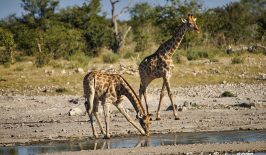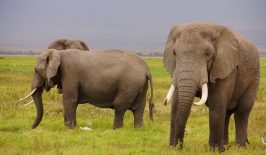With global biodiversity in crisis, conservationists around the world are devising more and more innovative ways to curb species loss. One of the latest initiatives is Wildlife Insights: a new tool that harnesses the power of AI to dramatically grow our knowledge about wildlife populations. But the project, which analyses photos taken on camera traps disguised in nature, may raise ethical questions too.
Wildlife Insights describes itself as “saving biodiversity with tech and AI”. The basic idea is fairly simple. Researchers from all over the world are free to batch upload photos that they’ve taken on hidden camera traps. These images are then fed into an AI, which analyses the images to identify the animal species’ captured. Given that these cameras routinely collect tens of thousands of images, it’s easy to imagine how drastically this could speed up the process of research. Consequently, conservationists could learn a lot more about what animals are living in particular areas, as well as tracking their movements. The data can be accessed from anywhere, including out in the field, via any device or computer. It’s also accessible to everyone – meaning anyone can access and explore what’s there and, even, potentially, leverage that data to influence policy and encourage decision-makers to act for the good of the animal world.
Widespread use of camera traps is nothing new: researchers have been using them for decades now to observe wild animals and monitor their populations. A few decades ago, scientists wanting to learn more about these species had little choice but to get up close and personal with them – whether that meant living alongside animals à la Jane Goodall, or resorting to cumbersome options such as physical traps. The drawbacks of such invasive methods are obvious. Not only can human presence distort research; it can also have detrimental effects on the subjects that researchers profess to protect. Additionally, there are limits to these methods – observing nocturnal animals, for example, is a huge challenge.
Enter technology. Cameras constructed especially for the purpose of capturing wildlife have, over the last 20 years or so, become ever-more advanced. Nowadays, we can tie motion-sensor camera traps discreetly to trees and even camouflage cameras in purpose-built animatronic animals.
Of course, filming rarely runs without a hitch. Curious or suspicious animals regularly destroy these units, which has naturally prompted manufacturers to make them all the more indestructible. But there are other concerns. Installing these systems in certain areas can also have unforeseen consequences for humans.
Since camera traps are usually used for benign ends – protecting vulnerable species, and gathering invaluable ecological knowledge – it may not be immediately obvious how such tools could actively harm humans. But “human bycatch” is common, and not everybody is happy about being caught on camera – whether that’s because they’re doing something wrong, or simply because their privacy has been breached.
For some, it might not seem like such a big deal to be caught on a stroll through the forest, but some cases are highly problematic: take, for example, the time an Austrian politician’s sexual antics were caught on a camera trap, or the potential invasion of indigenous groups’ privacy. Then, of course, there’s the endemic issue of poaching. Consequently, many of these cameras are destroyed, with a frequency that suggests something deeper is afoot than random acts of vandalism.
The Ethical Implications of Camera Surveillance
Chris Sandbrook, a lecturer in Geography at Cambridge, has been examining the issue of camera trap surveillance for some time. Over the years, he’s heard chilling stories from colleagues in the field, including camera traps being used by local authorities as a form of social control. “These devices have got lots of really exciting and wonderful uses. I would never want to see them all banned or something like that,” says Sandbrook. But, he adds, they also come with ethical implications that must be considered.
Sandbrook and his colleagues have been working on a set of guidelines for the appropriate use of surveillance technology in conservation, which he hopes may encourage greater caution and human rights respect for camera trap users. As Sandbrook acknowledges, the recently launched Wildlife Insights offers what seems, in many ways, like an invaluable service for researchers.
Wildlife Insights uses a rapidly growing AI, which can sort through photos en masse and learn as it goes. Manually labelling these photos is a slow and tedious task: while an expert might be able to sift through and label 1000 photos in a day, Wildlife Insights’ AI can do 30,000 – and they’re hoping that number could eventually climb to 100,000. “We’re faced with such an overwhelming data load these days,” says Tim O’Brien, a member of the Wildlife Insights team who has also worked with the Wildlife Conservation Society for 30 years. “Just from a data processing point of view, it’s fantastic.”
O’Brien remembers a time before camera traps were widely available, and can recall what a thrill it was to discover their growing potential in the late 1990s. Wildlife Insights could certainly make a lot of conservationists’ lives easier, as well as providing knowledge to the field that may not otherwise come to light. But again, there are potential concerns. A lot of the machine learning is built by Google, who also has access to the images. “We have a policy of not sharing or posting images of people,” O’Brien explains, though this doesn’t mean they won’t get uploaded as part of large batches, and he’s not sure yet what happens to these “human bycatch” images.
“I suppose that’s probably my general concern … what kind of insights Google might be drawing from the data,” says Sandbrook. “They [Google] don’t seem to have the best record when it comes to managing people’s data and using it for things that perhaps weren’t what everyone thought they were doing with it.”
There is little doubt that technology can be a panacea to the obstacles faced by many conservationists doing critical, and increasingly urgent, work. Wildlife Insights is yet another AI application that shows immense promise as another stepping stone towards protecting endangered species and precious natural ecosystems. But it also broaches some of the biggest questions posed in the digital era, from surveillance to big data. And by feeding potentially sensitive data into a Google-powered AI, it’s easy to see how privacy or human rights concerns might be vindicated. “I think these thoughts of the all-seeing eye do raise quite an important ethical question,” says Sandbrook. “I hope that they’ve thought them through and have some plans in place.”
This article is part of the RESET Special Feature “Artificial Intelligence – Can Computing Power Save Our Planet?” Explore the rest of our articles in the series right here.








